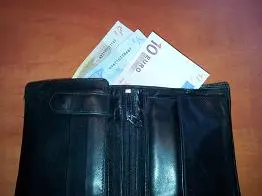What is Cash Flow? Definition, calculation and Example
How to calculate the cash flow of a company from the income statement?

What is cash flow? For many persons “cash flow” is a confusing subject. Yet, cash flow is a very important quantity that is used by finance professionals, and anyone who wants to know, for example, what is te value of this company? The reason for the confusion is that there are items on the income statement that are subtracted or added, while there is no money transferred. However, in reality it's not that difficult, so let us explain to you why. So far, we have continuously discussed cash flow on the previous pages, assuming it as an established amount. However, this is not realistic in practice. The person valuing a company must investigate what the most likely cash flows will be for the next five to ten years. But what is cash flow and how can you calculate cash flow? There is no specific formula for it, but it follows from a calculation. Before we work out an example and calculate cash flow based on a financial statement, let's first look at its definition.
Cash Flow Meaning and Definition
Cash flow refers to the flow of money in and out of a company or to and from an individual account over a certain period. Cash flow is an important measure of a company's financial health and can be positive or negative, depending on whether more money is coming in than going out, or vice versa. definition: the cash flow in a company is the total cash generated from revenues minus the cash spent on expenses, interest, and taxes. Cash flow can be calculated at any moment, and companies regularly use specially developed software to perform cash flow analyses to monitor the company's cash position. In the following, highly simplified, hypothetical "income statement", we illustrate what should and should not be included in the cash flow calculation.
Cash flow calculation from the income statement?
The cash flow in a business is the total cash generated by the business minus the cash spent, e.g. on costs, expenses, interest and taxes.
Let us illustrate this with a hypothetical and very simple income statement of a hypothetical business.
Income Statement: Hypothetical, Inc.
- Income/Revenue/Sales: 1.000.000
- Cost of Sales: 300.000
- Gross Income: 700.000
- Expenses: 400.000
- EBITDA: 300.000
- Ammortization: 50.000
- Depreciation: 80.000
- EBIT: 170.000
- Interest: 10.000
- Tax: 58.000
- Net Profit: 102.000
Looking at this Income Statement and taking the definition of cash flow into consideration, it is easy to find out what the cash flow for this company is. Below we will review this income statement line by line:
- This line represents the revenues, which in this example are equal to the turnover you generate.
- This represents the cost of the product you (re)sell. For example, a car dealer who sells a car must first buy it before they can resell it. The purchase price then belongs to the cost of sales. Since your invention does not yet exist, you cannot buy it to resell it, so cost of sales will likely not appear in your scenario. We have only included this because it is often seen in annual reports and financial statements.
- This is the gross income after deducting the cost of sales.
- Line 4 represents all costs associated with running the business, such as wages, rent, energy costs, raw materials needed to manufacture the product, etc.
- This shows the result of the company before, among other things, interest, depreciation, and taxes. EBITDA stands for Earnings Before Interest, Tax, Depreciation, and Amortization.
- This shows the amortization. For example, a company can deduct the investment made, such as in buildings, in installments for tax purposes. Companies often do this so that significant investments do not have to be taken in one year but spread over several years. Therefore, amortization is not a cash outflow.
- This represents the depreciation (or value reduction, write-off) of assets, such as machinery, cars, etc. In this respect, it is very similar to amortization. This means that a company can set aside an amount per year that is tax-deductible. Again, it should be noted that depreciation is not a cash outflow.
- EBIT represents Earnings Before Interest and Tax.
- This is the interest.
- This is the tax, and finally, we come to
- which represents the company's total profit.
We are going to calculate the cashflow
The question now is, what should you take as cashflow? The Net Profit, EBITDA, or EBIT?
The answer is none of these. We will need to derive the cashflow ourselves from the above 'income statement,' which is not so terribly difficult if you stick strictly to the definition. We normally calculate this by starting with the net profit and adding back every non-cash outflow item. In this example, there are two items that do not represent cash outflows: amortization and depreciation. So, we add these back to the profit to arrive at the cashflow. Therefore, the cashflow is now:
Cash Flow: 102.000 + 50.000 + 80.000 = 232.000
This is much more than the net profit amount. Keep in mind that this is a highly simplified example, but when you build your spreadsheet, you will see that there is a world of difference between profit and cashflow. Also important is EBITDA. This measure indicates the capacity of a company to generate cash. Cash is necessary for making further investments or paying interest in case loans need to be taken, although this is less likely if you have a venture capital or private equity firm as co-investors; they do not like interest debt and prefer equity in the company, but we are getting ahead of ourselves here.
By the way, during the startup phase, it will rarely happen that a company can show a positive cashflow (let alone profit). This is the phase where financing is needed, and investors must be sought.
So, in summary, we calculate cashflow with income and expenses
Some more remarks: income, also sometimes called “revenue” or “Sales” is self-explanatory. This is the cash generated by the sales of goods or services. After we subtract the “Cost of Sales” we arrive at “Gross Income.” Be aware that not all Income Statements will feature a “Cost of Sales” item. This item is important in a trading business, for example, a second hand car dealer sells a car (Sales) that he bought earlier(cost of sales). So far so good. Now we subtract “Expenses,” for example salaries, raw materials, office equipment etc., to arrive at the item Earnings Before Interest, Tax, Depreciation, and Amortization, or EBITDA. After subtracting the items depreciation and amortization we arrive at EBIT. Then we subtract the interest, pay the taxman, and arrive at the bottom line, Net Profit. So is this the cash flow? No, it is not and let me show you why.
If no cash is flowing.......no cash flow
Look again at the hypothetical Income Statement, and think about our definition of cash flow. If you look carefully you see that there are two items that represent no cash out- or inflow; these items are “Amortization” and “Depreciation” on lines 6 and 7. These two non-cash items are allowed by the taxman to be subtracted from income to arrive at the Net Profit figure; however, the cash remains in the business. Therefore these items must be added back to Net Profit to arrive at the cash flow.
There can be many more non-cash items that have to be added back, or cash items that have to be subtracted - one thinks for example at payments of (preferred) dividends or other gains or losses - to arrive at the cash flow.
We have shown that the difference in risk between various investments or projects, i, is introduced during the valuation through the discount rate, ri. We have compiled some discount rates in a table. Cashflows are calculated based on income and expenses. Cashflow is not equivalent to profit. Cash flow calculation and net present value (NPV) calculation are closely related in financial analysis. Cash flow refers to the actual inflows and outflows of money over time, typically from investments or operations. The Net Present Value takes those future cash flows and discounts them to their present value using a discount rate, often reflecting the cost of capital or required rate of return. The goal of NPV is to determine whether the present value of future cash flows exceeds the initial investment, helping investors assess the profitability of a project. The NPV, or value of the project, is best calculated with a spreadsheet that has the formulas readily available. OpenOffice for Windows and Linux, or NeoOffice for Mac OS X, are free and highly recommended.
Now we are well on our way to soon preparing a budget and cautiously performing our first valuation. And after this introduction to some basic concepts, we will resume the valuation of our startup with the method known as Comparables Analysis.

